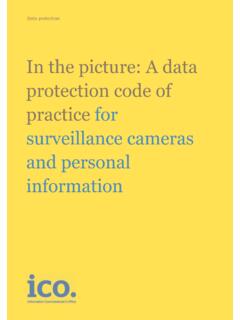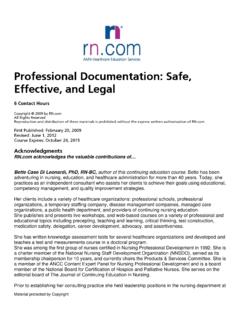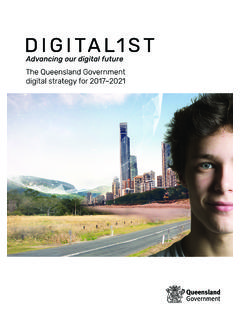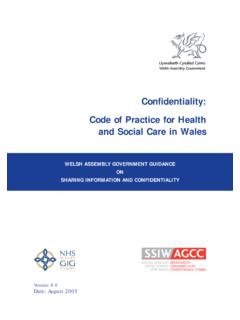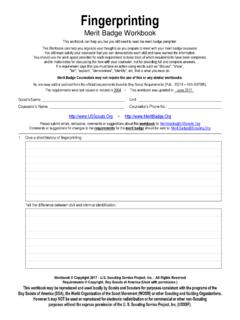Transcription of Statutory framework for the early years foundation stage
1 1 Statutory framework for the early years foundation stage Setting the standards for learning, development and care for children from birth to five Published: 31 March 2021 Effective: 1 September 2021 2 Contents Summary 3 About this Statutory framework 3 Expiry or review date 3 What legislation does this framework refer to? 3 Who is this framework for? 4 Introduction 5 Overarching principles 6 Section 1 The learning and development requirements 7 The areas of learning and development 7 Educational Programmes 8 early Learning Goals 11 Learning and Development Considerations 15 Section 2 Assessment 18 Progress check at age two 18 Assessment at the start of the reception year the Reception Baseline Assessment (RBA) 19 Assessment at the end of the EYFS the early years foundation stage Profile (EYFSP) 19 Information to be provided to the local authority 20 Section 3 The safeguarding and welfare requirements 21 Introduction 21 Child protection 21 Suitable people 23 Staff qualifications, training, support and skills 26 Key person 27 Staff.
2 Child ratios all providers (including childminders) 28 Health 32 Managing children s behaviour 34 Safety and suitability of premises, environment and equipment 35 Special educational needs 37 Information and records 38 Other Legal Duties 41 Annex A: Criteria for effective Paediatric First Aid (PFA) training 42 Annex B: Statutory guidance for the Reception Baseline Assessment (RBA) 44 3 Summary About this Statutory framework This framework is mandatory for all early years providers in England from 1 September 20211. Ofsted and inspectorates of independent schools have regard to the early years foundation stage (EYFS) in carrying out inspections and report on the quality and standards of provision. Ofsted publishes inspection reports at Ofsted may issue actions (in respect of any failure to meet a requirement in the document) and/or may issue a welfare requirements notice (in respect of Section 3). It is an offence for a provider to fail to comply with a welfare requirements notice.
3 early years childminder agencies are also under a duty to have regard to the EYFS in the exercise of their functions. The learning and development requirements in sections 1 and 2 of this framework , and the safeguarding and welfare requirements in section 3 of this framework , are indicated by the use of the word must . Additionally, early years providers must "have regard" to other provisions in these sections. These provisions are indicated by the use of the word should . "Having regard" to these provisions means that early years providers must take them into account when providing early years provision and should not depart from them unless there is good reason for doing so. Expiry or review date This framework remains in force until further notice. What legislation does this framework refer to? The learning and development requirements are given legal force by an Order2 made under section 39(1)(a) of the Childcare Act 2006 The safeguarding and welfare requirements are given legal force by Regulations3 made under section 39(1)(b) of the Childcare Act 2006 1 Section 46 of the Childcare Act 2006 enables the Secretary of State to confer exemptions from the learning and development requirements in certain prescribed circumstances.
4 2 The early years foundation stage (Learning and Development Requirements) Order 2007 ( 2007/1772), as amended. 3 The early years foundation stage (Welfare Requirements) Regulations 2012 ( 2012/938), as amended. 4 Who is this framework for? This framework is for all early years providers in England (from 1 September 2021): maintained schools; non-maintained schools; independent schools (including free schools and academies); all providers on the early years Register; and all providers registered with an early years childminder agency (CMA).4 4 The Childcare (Exemptions from Registration) Order 2008 ( ) specifies the circumstances in which providers are not required to register. 5 Introduction 1. Every child deserves the best possible start in life and the support that enables them to fulfil their potential. Children develop quickly in the early years and a child s experiences between birth and age five have a major impact on their future life chances.
5 A secure, safe and happy childhood is important in its own right. Good parenting and high quality early learning together provide the foundation children need to make the most of their abilities and talents as they grow up. 2. The early years foundation stage (EYFS) sets the standards that all early years providers must meet to ensure that children learn and develop well and are kept healthy and safe. It promotes teaching and learning to ensure children s school readiness and gives children the broad range of knowledge and skills that provide the right foundation for good future progress through school and life. 3. The EYFS seeks to provide: quality and consistency in all early years settings, so that every child makes good progress and no child gets left behind a secure foundation through planning for the learning and development of each individual child, and assessing and reviewing what they have learned regularly partnership working between practitioners and with parents and/or carers equality of opportunity and anti-discriminatory practice, ensuring that every child is included and supported 4.
6 The EYFS specifies requirements for learning and development and for safeguarding children and promoting their welfare. The learning and development requirements cover: the areas of learning and development which must shape activities and experiences (educational programmes) for children in all early years settings the early learning goals that providers must help children work towards (the knowledge, skills and understanding children should have at the end of the academic year in which they turn five) assessment arrangements for measuring progress (and requirements for reporting to parents and/or carers) 5. The safeguarding and welfare requirements cover the steps that providers must take to keep children safe and promote their welfare. 6 Overarching principles 6. Four guiding principles should shape practice in early years settings. These are: every child is a unique child, who is constantly learning and can be resilient, capable, confident and self-assured children learn to be strong and independent through positive relationships children learn and develop well in enabling environments with teaching and support from adults, who respond to their individual interests and needs and help them to build their learning over time.
7 Children benefit from a strong partnership between practitioners and parents and/or carers. importance of learning and development. Children develop and learn at different rates. (See the characteristics of effective teaching and learning at paragraph ). The framework covers the education and care of all children in early years provision, including children with special educational needs and disabilities (SEND). 7 Section 1 The learning and development requirements This section defines what providers5 must do, working in partnership with parents and/or carers, to promote the learning and development of all children in their care, and to ensure they are ready for year 1. The learning and development requirements are informed by the best available evidence on how children learn and reflect the broad range of skills, knowledge and attitudes children need as foundations for good future progress. early years providers must guide the development of children s capabilities with a view to ensuring that children in their care complete the EYFS ready to benefit fully from the opportunities ahead of them.
8 The EYFS learning and development requirements comprise: the seven areas of learning and development and the educational programmes (described below) the early learning goals, which summarise the knowledge, skills and understanding that all young children should have gained by the end of the reception year the assessment requirements (when and how practitioners must assess children s achievements, and when and how they should discuss children s progress with parents and/or carers) Development Matters6, non- Statutory curriculum guidance for the EYFS, is available to support providers in their delivery of the EYFS learning and development requirements. As this document is non- Statutory , Ofsted and inspectorates of independent schools will not have regard to it in carrying out inspections and it is up to providers to decide how they approach the curriculum. The areas of learning and development There are seven areas of learning and development that must shape educational programmes in early years settings.
9 All areas of learning and development are important and inter-connected. 5 Providers offering care exclusively before and after school or during the school holidays for children who normally attend reception (or older) class during the school day (see paragraph ) do not need to meet the learning and development requirements. However, providers offering care exclusively before and after school or during the school holidays for children younger than those in the reception class age range, should continue to be guided by, but do not have to meet, the learning and development requirements. All such providers should discuss with parents and/or carers (and other practitioners/ providers as appropriate, including school staff/teachers) the support they intend to offer. 6 8 Three areas are particularly important for building a foundation for igniting children s curiosity and enthusiasm for learning, forming relationships and thriving.
10 These are the prime areas: communication and language physical development personal, social and emotional development Providers must also support children in four specific areas, through which the three prime areas are strengthened and applied. The specific areas are: literacy mathematics understanding the world expressive arts and design Educational Programmes Educational programmes must involve activities and experiences for children, as set out under each of the areas of learning. Communication and Language The development of children s spoken language underpins all seven areas of learning and development. Children s back-and-forth interactions from an early age form the foundations for language and cognitive development. The number and quality of the conversations they have with adults and peers throughout the day in a language-rich environment is crucial. By commenting on what children are interested in or doing, and echoing back what they say with new vocabulary added, practitioners will build children's language effectively.











